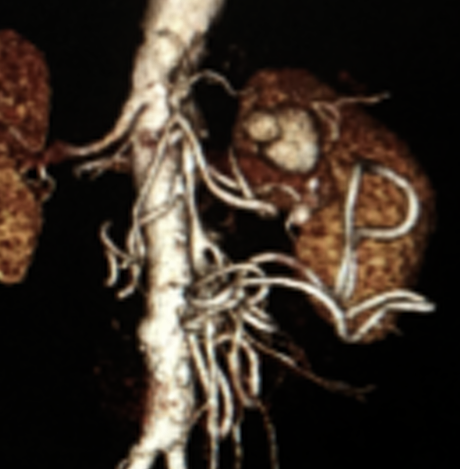Back to 2016 Annual Symposium ePosters
Concomitant Splenic Aneurysm with Severe Mesenteric Occlusive Disease: Endovascular Repair Strategy
Anthony Feghali, MD, Palma Shaw, MD.
Upstate Medical University, Syracuse, NY, USA.
Objective: Describe an endovascular strategy to reduce potential complications of mesenteric ischemia and/or splenic artery rupture in the presence of combined mesenteric aneurysmal and occlusive disease.
Methods: A 69-year-old female with oxygen-dependent COPD was found to have an incidental 3.6 cm splenic artery aneurysm on a non-contrast CT during evaluation of intermittent abdominal discomfort. A CTA confirmed the splenic aneurysm and showed severe stenosis of the celiac and superior mesenteric artery with a large marginal artery supplying the intestine. There was no history of postprandial pain, weight loss, or emptying GI symptoms. An endovascular strategy was planned to treat the large splenic aneurysm and avoid mesenteric ischemia as a complication due to reduction of mesenteric collateral blood flow. Using a brachial approach under local anesthesia, through a 6 French sheath, lateral angiography confirmed the CTA findings. The following sequence was used to treat both pathologies: SMA covered stent, vertebral catheter through celiac stenosis, high flow microcatheter with coiling (detachable coils) of the splenic aneurysm, and bare metal stent of celiac stenosis avoiding coverage of branch vessel.
Results: Post-procedure angiography showed widely patent stented celiac and SMA. There was no flow into the splenic aneurysm. The patient recovered without incident. CT scan is pending.
Conclusions: The combination of mesenteric aneurysmal and occlusive disease is challenging as treatment of either alone may lead to ischemia or rupture. The strategy used in this case avoids this potential pitfall. Both pathologies should be addressed in a single procedure and in a sequence that will reduce the risk of mesenteric ischemia during or after the procedure, and protect the patient from aneurysm rupture.

Back to 2016 Annual Symposium ePosters
|






